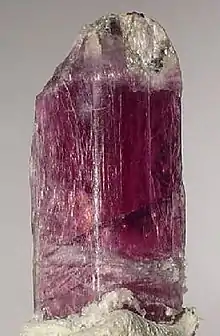| Hexagonite | |
|---|---|
 | |
| General | |
| Category | mineral variety of tremolite |
| Formula (repeating unit) | Ca2Mg5 (Si8O22) (OH)2 |
| Space group | monoclinic – prismatic |
| Identification | |
| Color | red to pink, lilac to purple |
| Crystal habit | elongated, bladed crystals, granula |
| Twinning | simple, multiple |
| Cleavage | [110] perfect; [010] distinct |
| Fracture | uneven |
| Tenacity | brittle |
| Mohs scale hardness | 5.0–6.0 |
| Luster | vitreous |
| Refractive index | 1.599–1.637 biaxial ( - ) |
| Birefringence | 0.019–0.028 |
| Pleochroism | bluish–red, deep rose, deep red–violet |
| Dispersion | weak, r < v |
Hexagonite is the red to pink, lilac to purple manganoan variety of tremolite. A rare amphibole, it can be transparent, translucent, and rarely opaque.
Properties
Hexagonite is pleochroic, potentially displaying varying shades of blue, violet, purple, or red.[1] It is also known as "mangan-tremolite", since the manganese imparts the mineral's unique colors. Pink, lilac, and purple are the most common colors.[1] Hexagonite has been successfully faceted.[1]
Chemical formulae and history
Tremolite was discovered in 1789.[2] Hexagonite, a varietal form of tremolite, has a Mohs hardness of 5.0-6.0.[3] Like tremolite, it is a calcium magnesium silicate hydroxide with the formula: Ca2Mg5 (Si8O22) (OH)2.[3]
The mineral was given the name, hexagonite, because its crystal structure was believed at one time to be hexagonal. Since then, however, it has been found to be monoclinic.[3]
Occurrence
The mineral is found primarily in the Balmat-Edwards zinc district of Edwards, St. Lawrence County, New York, United States.[4] It was also found in the Czech Republic in the Chýnov caves.[5]
References
- 1 2 3 Hexagonite Gemstone Information; Gem Data website; accessed August 2016
- ↑ Tremolite on Mindat.org
- 1 2 3 Hexagonite on Mindat.org
- ↑ Balmat Hexagonite; article; July 27, 2015; Fred Haynes blog; "WCGMC Activity;" accessed Aug 2017
- ↑ Litochleb J, Sejkora J (2007) Occurrence of tremolite-hexagonite in dolomite marbles in the Chýnov cave (southern Bohemia). Minerál 15: 124-126 (in Czech)